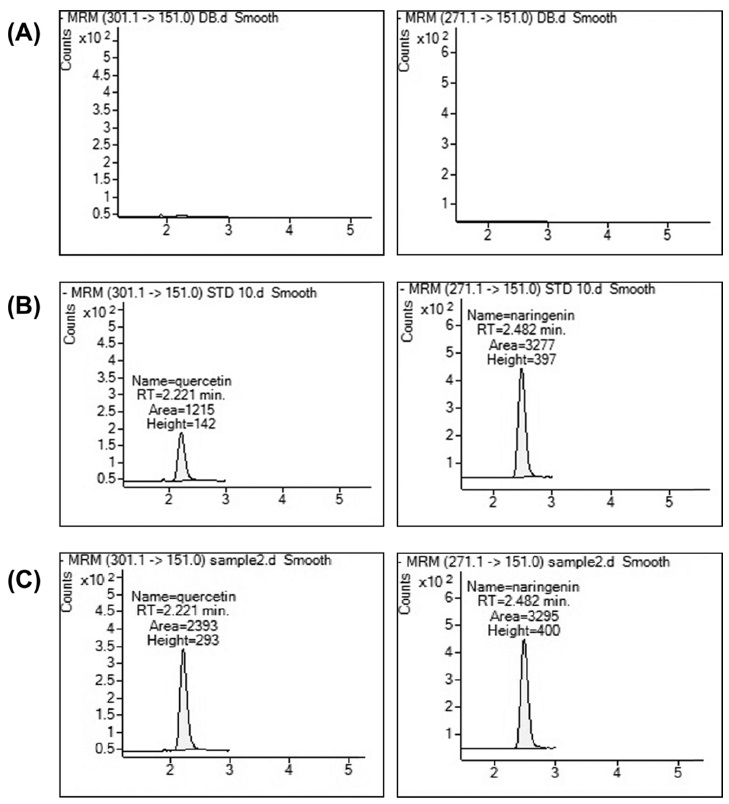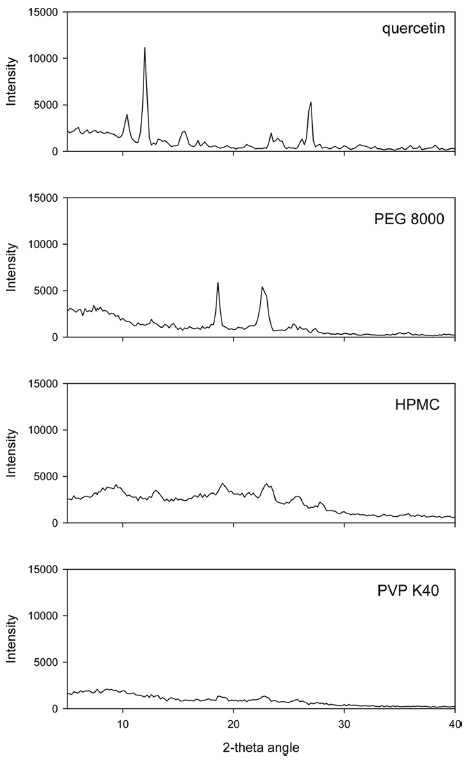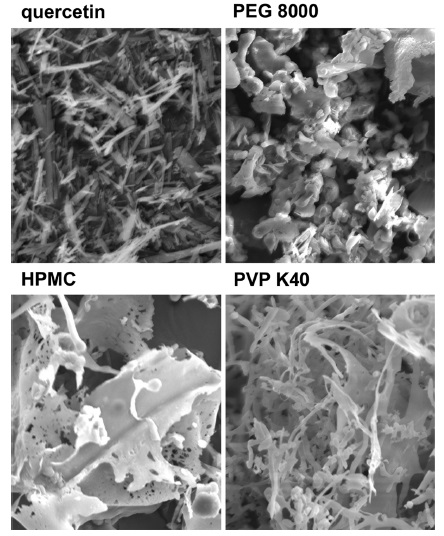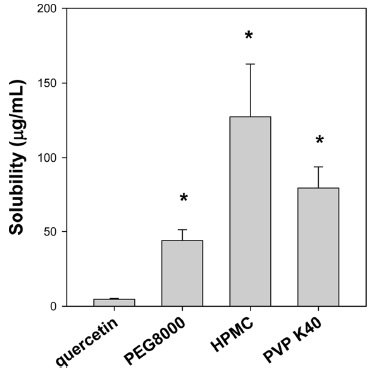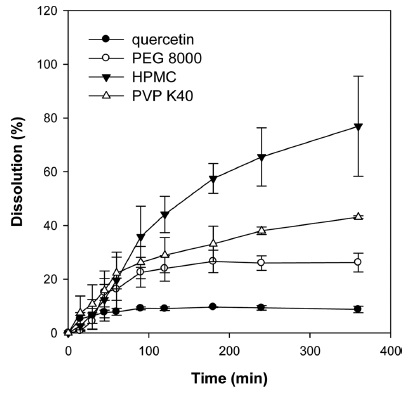



We prepared solid dispersion formulations of quercetin to enhance its solubility and dissolution rate. Various quercetin-loaded solid dispersion were tested with quercetin, poloxamer 407, and carrier such as hydroxypropyl methyl cellulose (HPMC), polyethylene glycol 8000 (PEG 8000), and polyvinylpyrrolidone K40 (PVP K40) using solvent evaporation and freeze drying methods in terms of both the aqueous solubility and the dissolution rates of quercetin. The solubility of quercetin as its solid dispersion formulations was markedly improved compared with that of quercetin powder. Especially, highest solubility of quercetin was observed when HPMC was used as a carrier. The cumulative dissolution of quercetin within 360 min from solid dispersion composed of quercetin, poloxamer 407, and HPMC was 8.8-fold higher than the dissolution of pure quercetin. The results of powder X-ray diffraction (XRD) and scanning electron microscope (SEM) indicated that quercetin transformed from a crystalline to an amorphous form through the solid dispersion formulation process. These results suggest that the solid dispersion formulation of quercetin with poloxamer 407 and HPMC could be a promising option for enhancing the solubility and dissolution rate of quercetin.
Quercetin, 3,3’,4’,5,7-pentahydroxyflavone, is a dietary flavonoid widely present in plant foods such as fruits, vegetables, and nuts.1 Quercetin is known to be a prominent anti-oxidant that inactivates the metal iron responsible for the generation of reactive oxygen species and suppresses oncogenesis and tumor progression signaling pathways.1 Quercetin also has a various pharmacological effects such as chemoprevention, anti-inflammation, anti-aging, and inhibition of cardiovascular diseases.2,3
In spite of this wide spectrum of pharmacological properties, clinical applications of quercetin are still limited due to its poor bioavailability resulted from limited aqueous solubility, poor gastrointestinal permeability, and extensive metabolism.4 Therefore, it is highly necessary to develop a new formulation of quercetin with an enhanced solubility and dissolution rate.
A widely used strategy for enhancing low solubility and limited dissolution rate is a solid dispersion system, in which the drug is incorporated in an inert hydrophilic carrier.5 In a solid dispersion system, the solubility and dissolution profile can be improved through the amorphous solid state and reduced particle size of the drug.6 Moreover, the use of hydrophilic carriers increases the wettability of hydrophobic drugs.5,7
The purpose of the present study, therefore, was to develop an oral solid dispersion formulation of quercetin using poloxamer 407 as a surfactant and a hydrophilic polymer as a carrier. To investigate the effect of various carriers on both the aqueous solubility and the dissolution rate of quercetin in the solid dispersions formulations, we prepared solid dispersion formulation using hydroxypropyl methyl cellulose (HPMC), polyethylene glycol 8000 (PEG 8000), and polyvinylpyrrolidone K40 (PVP K40) as carriers, respectively. We then evaluated the solubility, dissolution behavior, and physicochemical characteristics among the quercetin-loaded solid dispersion formulations with various carriers.
Quercetin, naringenin (internal standard), poloxamer 407, PEG 8000, and PVP K40 were obtained from Sigma-Aldrich Chemical Co. (St. Louis, MO, USA). HPMC was obtained from ACROS Organics (Geel, Belgium). Acetonitrile, ethyl alcohol, and pure water were obtained from Burdick & Jackson (SK Chemicals, Ulsan, Korea) and were of HPLC grade. All other chemicals used were of analytical grade.
>
Preparation of quercetin-loaded solid dispersions
Quercetin-loaded solid dispersions were prepared with quercetin, poloxamer 407 (as a surfactant), and a hydrophilic polymer (as a carrier) at weight ratio of 1 : 1 : 2 using a two-step procedure, consisting of solvent evaporation and freeze drying. In detail, 100 mg of quercetin and 100 mg of poloxamer 407 were dissolved in ethyl alcohol. The solution was evaporated by using a rotary evaporator (N-1110V-W, EYELA, Tokyo, Japan). Subsequently, 200 mg of HPMC, PEG 8000 and PVP K40 was added to each of the dried residue, respectively, and water was then added to mixture with stirring to obtain a clear solution. The solution was frozen at -80℃ for 6 h in deep freezer (MDF-U50V, Sanyo, Osaka, Japan) and underwent freeze-drying at -120℃ for 72 h using a freeze dryer (FDCF-12012, Operon, Gyeonggi-do, Korea). After freeze drying, the resulted samples were sieved through a KP sieve (mesh size 0.84 mm) and stored in a desiccator.
X-ray powder diffraction was performed at room temperature with an X-ray diffractometer (Ultima IV; Rigaku Co., Tokyo, Japan) using Cu Kα radiation, generated at 40 mA and 40 kV. Data were obtained from 5 to 40° (2θ) at a step size of 0.02° and a scanning speed of 5°/min.
>
Scanning electron microscope (SEM)
Surface characteristics of the samples were studied by SEM from 150 to 1,000x magnifications. A double sided carbon tape was affixed onto platinum stubs. The powder sample was sprinkled onto the tape. The platinum stubs were placed in the vacuum chamber of SEM. The samples were observed for morphological characteristics using a gaseous secondary electron detector with working pressure of 0.8 Pa and acceleration voltage of 10.00 kV.
Excess amounts (about 5 mg as quercetin) of quercetin powder and quercetin-loaded solid dispersions were placed in 15 mL round-bottom tube and added to 3 mL water. These suspensions were shaken at 25℃ for 5 h, centrifuged at 13,200 rpm for 20 min (6415R, Eppendorf, Hambrug, Germany), and filtered through a nylon membrane filter (0.45 mm). The filtrates were suitably diluted with acetonitrile into the calibration curve range, and analyzed for quercetin using a liquid chromatography coupled with tandem mass spectrometry (LC-MS/MS), as described below.
The dissolution profiles of quercetin were determined according to a USP dissolution paddle method. Briefly, dissolution tests were carried out in 900 mL distilled water for 360 min in a D-63150 dissolution test apparatus (Erweka, Heusenstamm, Germany) at 37℃. Samples were tested in four groups. The first group was quercetin powder; and the other three groups were the quercetin-loaded solid dispersion formulation containing HPMC, PEG 8000 and PVP K40, respectively. Quercetin powder, three kinds of the quercetin-loaded solid dispersion formulation (all equivalent to 5 mg quercetin) were packed into a gelatin capsule and each capsule was then placed inside the sinker. Samples were collected at 0, 15, 30, 45, 60, 90, 120, 180, 240, and 360 min. An aliquot (5 mL) of the medium was collected and filtered through a nylon membrane filter (0.45 mm). The filtrates were suitably diluted with acetonitrile into the calibration curve range, and analyzed for quercetin with LC-MS/MS system, as described below. The same volume of fresh medium was replaced after each sampling.
The concentration of quercetin was quantified by LC-MS/MS system with a slight modification.8 Briefly, quercetin concentration was analyzed using an Agilent 6430 Triple Quadrupole LC-MS/MS system (Agilent, Wilmington, DE, USA). The separation was performed on a Luna C18 column (2.0 mm × 150 mm, 5 μm; Phenomenex, Torrance, CA, USA) using a mobile phase consisting of water:acetonitrile (35:65 v/v) with 0.1% formic acid at a flow rate of 0.2 mL/min. Quantification was carried out using multiple reaction monitoring (MRM) at
All data are expressed as means ± standard deviation (SD) of three independent experiments. Differences between treatments were evaluated using the unpaired
The X-ray diffraction patterns of quercetin powder, quercetin-loaded solid dispersion formulations are represented in Figure 2. The diffractogram of quercetin powder showed a series of distinct peaks at a diffraction angle (2θ) of 10.45°, 12.28°, 15.17°, 23.71°, 27.54°, indicating a typical crystalline structure.9 The XRD patterns of quercetin-loaded solid dispersion formulations showed the characteristic peak of quercetin almost disappeared in the solid dispersion formulations, implying that quercetin was no longer present as a crystalline form and existed in the amorphous state in its solid dispersion formulation.
>
Scanning electron microscope (SEM)
In SEM images, quercetin powder showed sharp and needle-like shapes (Figure 3). On the contrary, the morphology of solid dispersion containing HPMC and PVP K40 exhibited the porous sponge-like appearance and that of solid dispersion containing PEG 8000 exhibited the irregular agglomerate shapes (Figure 3). However, irrespective of carriers formulated, quercetin in the solid dispersion was seemed to be homogeneously dispersed in the carriers as there was no quercetin crystal observed. These results implied that quercetin was dispersed uniformly on the surface of carrier at the molecular level, which supported by XRD results. As a result, the size reduction and uniform dispersion of the drug over carrier were achieved during the formation of solid dispersion.
To evaluate the solubility of quercetin from the various solid dispersion formulations, we dissolved the quercetin powder and quercetin-loaded solid dispersion formulations in the water. The aqueous solubility of quercetin powder was 4.6 μg/mL, indicated that quercetin is hydrophobic and hardly dissolves in water. The solubility of quercetin in solid dispersion formulations was significantly increased in compared with that in quercetin powder (Figure 4). However, the hydrophilic carriers had a different influence on quercetin solubility in the order of HPMC, PVP K40, and PEG 8000. Finally, the solid dispersion formulation containing HPMC as a carrier showed the maximum quercetin solubility of 127.4 μg/mL.
We investigated the dissolution profiles of quercetin and quercetin-loaded solid dispersion formulations. As shown in Figure 5, the dissolution fraction of pure quercetin remained at about 9% for 360 min. However, all of the solid dispersion formulations showed a significantly greater dissolution rate compared to quercetin powder. After 360 min there were about a 8.8-fold, 5.0-fold, and 3.0-fold increase in the cumulative release of drug from the solid dispersion containing HPMC, PVP K40, and PEG 8000, respectively, compared to the quercetin powder (HPMC : 76.9%
The strategy for enhancing the aqueous solubility and dissolution rate is a reasonable way to increase low bioavailability of phytochemical drug and to potentiate its therapeutic efficacy. According to the literature, the increase in the solubility has been reported to be important for the improvement of oral bioavailability and efficacy of quercetin.10,11 The purpose of this study was to develop the solid dispersion formulation of quercetin to enhance the solubility and dissolution rate. Considering it is advantageous in solid dispersion systems that molecular dispersion of the drug is achieved over carrier matrix, the drug is needed to be homogeneously mixed with the carrier during the preparation of solid dispersion.12 Therefore, quercetin-loaded solid dispersion was formulated by a two-step procedure with solvent evaporation and freeze drying. In detail, quercetin and poloxamer 407 were dissolved in ethyl alcohol first, and the solution of quercetin and surfactant was dried by the solvent evaporation, and then this residue and hydrophilic polymer were dissolved in water. Finally, the quercetin-loaded solid dispersion formulation was prepared from a clear homogeneous solution of quercetin, poloxamer 407, and a hydrophilic polymer through the freeze-drying method.
Solid-state characterization using XRD and SEM suggested that quercetin transformed from a crystalline state to an amorphous form through the solid dispersion processes and was homogeneously dispersed in the carrier matrix (Figure 2, 3). These significant changes in the formation of solid dispersion resulted in a marked increase in the surface area and solubility rate of quercetin in solid dispersion formulations when compared to quercetin powder.
As expected from the XRD and SEM results, the solubility of quercetin incorporated in the solid dispersion formulation was significantly increased compared with that of the corresponding powder (Figure 4). However, the solubility enhancement in the solid dispersion formulations was quite different according to the hydrophilic polymer used in the formulation as an order of HPMC, PVP K40, and PEG 8000.
It is interesting that initial dissolution rate of quercetin in the solid dispersion contained PVP K40 was highest among the solid dispersion tested in this study, and followed by HPMC and PEG 8000. These results seemed to be partly attributed to the structure of solid dispersion. The solid dispersion contained PVP K40 showed more porous structure than the other two formulations, which increased to the surface area for dissolution and contributed to the rapid dissolution (Figure 3).
We should note that in vivo evaluation of oral bioavailability and efficacy assessment need to be further investigation to optimized this solid dispersion of quercetin, poloxamer 407, and HPMC at a ratio of 1 : 1 : 2 (w/w/w), which was under investigation in our lab. On the other hand, based on the solubility and dissolution profiles, as well as the physicochemical characteristics of the newly developed quercetin formulations, solid dispersion approach might be one of potential options for oral preparations because of their improved solubility and dissolution properties.
In conclusion, the water-soluble formulation of quercetin was prepared by the solvent evaporation and freeze drying methods. Solid dispersion formulation showed enhanced solubility and rapid dissolution as compared to quercetin. As a result, the present formulation offers an effective means of overcoming problems related to solubility and dissolution of quercetin. Solid dispersion preparation with poloxamer 407 and HPMC may be a promising approach to improve the solubility and dissolution of quercetin.
